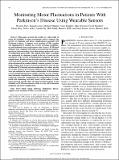| dc.contributor.author | Patel, Shyamal | |
| dc.contributor.author | Lorincz, Konrad | |
| dc.contributor.author | Hughes, Richard Allen | |
| dc.contributor.author | Huggins, Nancy | |
| dc.contributor.author | Growdon, John Herbert | |
| dc.contributor.author | Standaert, David | |
| dc.contributor.author | Akay, Metin | |
| dc.contributor.author | Dy, Jennifer | |
| dc.contributor.author | Welsh, Matthew D | |
| dc.contributor.author | Bonato, Paolo | |
| dc.date.accessioned | 2010-05-17T16:37:03Z | |
| dc.date.issued | 2009 | |
| dc.identifier.citation | Shyamal Patel, Konrad Lorincz, Richard Hughes, Nancy Huggins, John Growdon, David Standaert, Metin Akay, Jennifer Dy, Matt Welsh, and Paolo Bonato. 2009. Monitoring motor fluctuations in patients with
Parkinson’s disease using wearable sensors. IEEE Transactions on Information Technology in Biomedicine 13(6): 864-873. | en_US |
| dc.identifier.issn | 1089-7771 | en_US |
| dc.identifier.uri | http://nrs.harvard.edu/urn-3:HUL.InstRepos:4099742 | |
| dc.description.abstract | This paper presents the results of a pilot study to
assess the feasibility of using accelerometer data to estimate the
severity of symptoms and motor complications in patients with
Parkinson’s disease. A support vector machine (SVM) classifier
was implemented to estimate the severity of tremor, bradykinesia
and dyskinesia from accelerometer data features. SVM-based
estimates were compared with clinical scores derived via visual inspection
of video recordings taken while patients performed a series
of standardized motor tasks. The analysis of the video recordings
was performed by clinicians trained in the use of scales for the
assessment of the severity of Parkinsonian symptoms and motor
complications. Results derived from the accelerometer time series
were analyzed to assess the effect on the estimation of clinical scores
of the duration of the window utilized to derive segments (to eventually
compute data features) from the accelerometer data, the use
of different SVM kernels and misclassification cost values, and the
use of data features derived from different motor tasks. Results
were also analyzed to assess which combinations of data features
carried enough information to reliably assess the severity of symptoms
andmotor complications.Combinations of data features were
compared taking into consideration the computational cost associated
with estimating each data feature on the nodes of a body
sensor network and the effect of using such data features on the
reliability of SVM-based estimates of the severity of Parkinsonian
symptoms and motor complications. | en_US |
| dc.description.sponsorship | Engineering and Applied Sciences | en_US |
| dc.language.iso | en_US | en_US |
| dc.publisher | Institute of Electrical and Electronics Engineers | en_US |
| dc.relation.isversionof | doi:10.1109/TITB.2009.2033471 | en_US |
| dc.relation.hasversion | http://www.eecs.harvard.edu/~mdw/papers/parkinsons-titb09.pdf | en_US |
| dash.license | LAA | |
| dc.subject | body sensor networks | en_US |
| dc.subject | Parkinson’s disease | en_US |
| dc.subject | support vector machines (SVMs) | en_US |
| dc.subject | wearable sensors | en_US |
| dc.title | Monitoring Motor Fluctuations in Patients With
Parkinson’s Disease Using Wearable Sensors | en_US |
| dc.type | Journal Article | en_US |
| dc.description.version | Version of Record | en_US |
| dc.relation.journal | IEEE Transactions on Information Technology in Biomedicine | en_US |
| dash.depositing.author | Welsh, Matthew D | |
| dc.date.available | 2010-05-17T16:37:03Z | |
| dc.identifier.doi | 10.1109/TITB.2009.2033471 | * |
| dash.contributor.affiliated | Hughes, Richard Allen | |
| dash.contributor.affiliated | Bonato, Paolo | |
| dash.contributor.affiliated | Welsh, Matt | |
| dash.contributor.affiliated | Growdon, John | |


